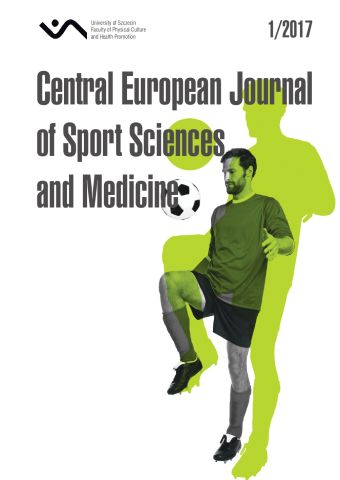
ISSN: 2300-9705
eISSN: 2353-2807
OAI
DOI: 10.18276/cej.2017.1-07




Lista wydań /
Vol. 17, No. 1/2017
Surgical Treatment and Rehabilitation of Trigger Thumb and Finger
| Autorzy: |
Anna
Deskur
Pomeranian Medical University Zbigniew Deskur Department of Physical Education and Health Promotion, University of Szczecin |
| Słowa kluczowe: | surgical treatment and rehabilitation of trigger thumb and finger trigger thumb and finger |
| Data publikacji całości: | 2017 |
| Liczba stron: | 6 (61-66) |
Abstrakt
The aim of the study was to evaluate the results of surgical treatment and rehabilitation of patients with trigger thumb and finger. In 40 patients, comprising 30 women and 10 men aged 26 to 64, a total of 42 cases of trigger thumb and finger. In the preoperative period, the severity of changes were studied according to the classification developed by Newport et al. Five patients were classified in the first stage, 28 in the second, 6 in the third, and 1 in the fourth. The mean duration of symptoms was five months. The indication for surgery was a lack of improvement following conservative treatment. All of the patients were treated surgically using the open method by cutting the flexor tendon sheath in part A1. The rehabilitation treatment included exercises to improve the range of mobility of the thumb and fingers and to stretch, grelax, and strengthen muscles. Neuromobilisation and automobilisation exercises were conducted. After 5 months, swelling, pain and restricted mobility of the thumb and fingers subsided in all patients. There were no ‘jumping’ symptoms. Apart from a slight transitory inflammatory reaction in 2 patients there were no complications. In patients with trigger finger, open surgery and competent rehabilitation therapy enables the achievement of very good results, with a low complication rate.
Pobierz plik
Plik artykułu
Bibliografia
| 1. | Cakmak, F., Wolf, M.B., Bruckner, T., Hahn, P., Unglaub, F. (2012). Follow-up investigation of open trigger digit release. Arch Orthop Surg, 132, 685–691. |
| 2. | Choudhury, M.M., Tay, S.C. (2013). Outcome of traction tenolisis in open trigger finger release – a retrospective review. Hand Surgery, 18 (3), 375–379. |
| 3. | Deskur, Z., Deskur, A., Zawadzki, M. (2014). Influence of selected phisical excercises to improve outcome in patients operated for carpal tunel syndrome in own material. Central European Journal of Sport Sciences and Medicine, 8 (4), 47–51. |
| 4. | Finsen, V., Hagen, S. (2003). Surgery for trigger finger. Hand Surgery, 8 (2), 201–203. |
| 5. | Froimson, A. (1999). Tenosynovitis and tennis elbow. In: Green, D.P., et al. (eds.), Green’s operative hand surgery, wyd. 4. Churchill Livingstone. |
| 6. | Kużdżał A. (2009). Atlas rehabilitacji ruchowej. Forum. |
| 7. | Lange-Riess, D., Schuh, R., Honle, W., Schuh, A. (2009). Long-term results of surgical release of trigger finger and trigger thumb in adults. Arch Orthop Trauma Surg., 129, 1617–1619. |
| 8. | Lim, M.H., Lim, K.K., Rasheed, M.Z., Narayanan, S., Beng-Hoi, T.A. (2007). Outcome of open trigger digit release. J Hand Surg Eur., 32 (4), 457–9. |
| 9. | Moriya, K., Uchiyama, T., Kawaji, Y. (2005). Comparison of the surgical outcomes for trigger finger and trigger thumb: preliminary results. Hand Surgery, 10 (1), 83–86. |
| 10. | Papież, K., Trybus, M., Stepańczak, B., Łoboda, K., Pokrowiecki, W., Gądek, A. (2013). Ocena wyników leczenia operacyjnego palców trzaskających (przeskakujących) i poprawy jakości życia w oparciu o kwestionariusz PEM (Patient Evaluation Measure). Przegląd Lekarski, 70 (7), 437–439. |
| 11. | Turowski, G.A., Zdanowicz, P.D., Thomson, J.G. (1997). The results of surgical treatment of trigger finger. J Hand Surg, 22A, 145–49. |
| 12. | Wang, J., Zhao, J.G., Liang, C.C. (2013). Percutaneous release, open surgery, or corticosteroid injection, which is the best treatment method for trigger digits? Clin Orthop Relat Res, 471, 1879–1886. |
| 13. | Will, R., Lubahn, J. (2010). Complications of open trigger finger release. J Hand Surg, 35, 594. |